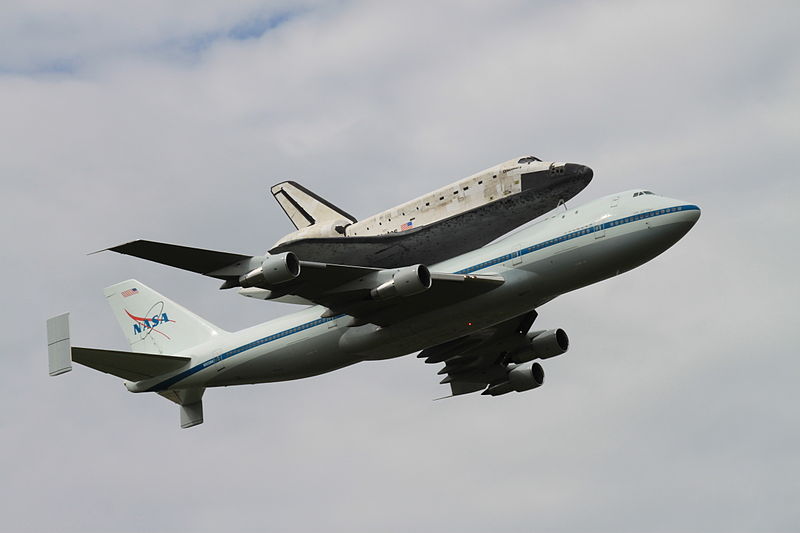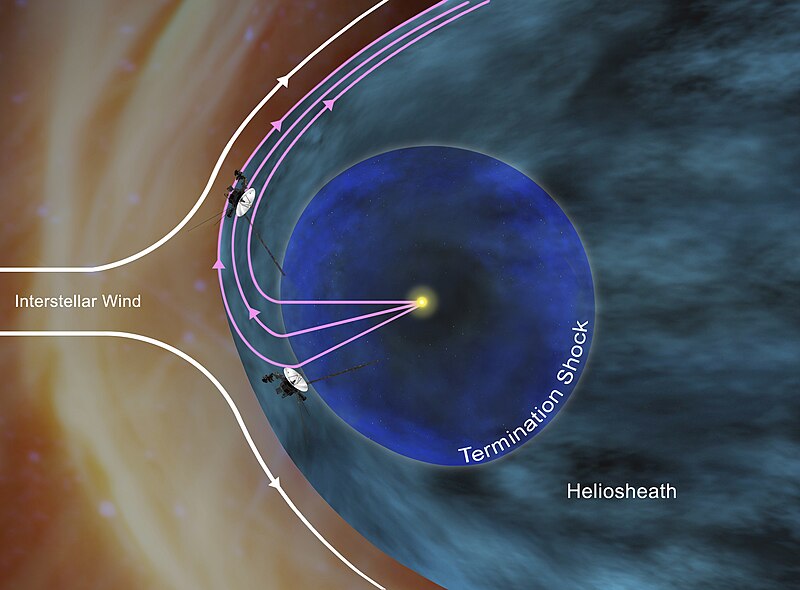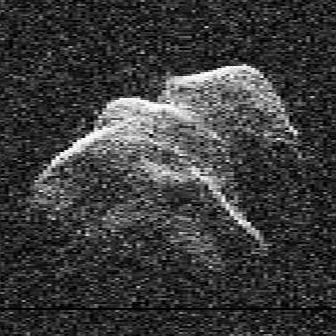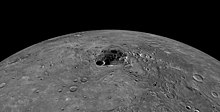A lot of neat stuff has happened this year in the world of science, and it wasn't easy narrowing things down. My weekly roundups include three cool things per week, but since this is for the entire year, I've decided to go with my personal favorite top five science stories for 2012. Enjoy, and have a Happy New Year!
5. The Transit of Venus
With the next transit over 100 years away, this was our generation's last chance to get to see our neighboring planet Venus in full daylight.
Really full daylight.
In fact, you couldn't even view it without safety equipment, because Venus was crossing the path of our Sun. The transit occurred on June 5th, 2012 and I was extremely lucky to get to see it happen. I live in Boston, which was completely cloudy that day, but happened to be on vacation in California at the time, where it was nice and sunny! With the help of some eclipse glasses, I had no problem seeing our sister planet passing in front of our Sun, silhouetting it brilliantly in the sky.
And I wasn't alone. Around the world, scientists were recording this event and using it to mimic our search for exoplanets. One of the ways to find planets around other stars is to watch for their own transits, and record the dips in sunlight and even the light filtering through the exoplanet atmospheres to determine their composition. The transit of Venus allowed for scientists to refine this technique in our own solar system. What a cool opportunity. I just couldn't resist including this awesome event in my Top 5.
4. Light Remains Reigning Speed Champion of the Universe
Sometimes, major news in science doesn't come from new discoveries, but in the defense of old ones.
In 2011, an experiment appeared to show that neutrinos were traveling faster than light. This obviously caused a huge amount of uproar, confusion, and excitement. But to make a long story short: they were wrong. Neutrinos did not travel faster than light.
In the original experiment, neutrinos (small subatomic particles) were measured to travel in a particle accelerator 60.7 nanoseconds faster than light could travel. However, this year it was reported that there were two major sources of error in the experiments of 2011: a faulty GPS link, and a clock that ticked slightly faster than it should. Combined, these two errors created the faster-than-light anomaly.
I include this in my Top 5, because it's always important to acknowledge how much of science is about explaining bizarre observations. If something seems unlikely, it probably isn't real. Mounds of evidence need to exist in favor of the unlikely scenario before it can be accepted as fact. This particular science story is a wonderful example of why that rarely happens. Human error is prevalent in experiments, and thus scientific studies are always about repetition. If you can repeat your results, you might be onto something. If not, look closer and you'll eventually find what went wrong.
Science-y advice for 2013: remember this concept the next time someone tells you something that seems unbelievable. (Hint: you probably shouldn't believe it.)
3. Space Shuttle Program Ends and SpaceX Takes Up the Challenge
With the space shuttle program going into retirement and the various shuttles being delivered to museums around the country, SpaceX launched the first commercial craft to dock with the International Space Station.
SpaceX's Dragon spacecraft delivered a load of cargo to the ISS on May 25, 2012. This pushes the potential of commercially designed spacecraft beyond just the realm of wealthy and imaginative corporations and fully into reality. While some are still concerned about privatizing space travel, I see it as the next logical step in technology.
SpaceX's Dragon capsule was successfully recovered after landing in the Pacific Ocean on May 31st. It is now approved to re-supply the ISS as needed, and has already been back to the ISS as of October of this year.
With this successful year of missions behind it, a variant of the Dragon is likely to be developed to deliver supplies to Mars in advance of a proposed (and once again, privatized) human visit down the line. I'm keeping a watchful eye on all of this, because I wouldn't be surprised at all if they succeed in this next step.
2. Higgs Boson Found!
No 2012 Top Science Stories list is complete without a nod of the head to CERN and their long-awaited discovery of the Higgs boson particle.
Announced on July 4th, 2012, CERN revealed that two different studies both identified a particle that matches what the Higgs boson should be. However, for the time being, CERN is careful not to say that it's definitively the Higgs boson, just in case something odd pops up. Once again, a great example of science testing and retesting itself to be as sure as possible.
This discovery is a huge deal, because the Higgs boson is responsible for the existence of mass as we know it. It's a particle of the standard model of physics that had yet to ever be observed, but has been predicted to exist for 50 years. This thing needs to exist for modern physics to make any sense.
Because of its extreme importance to physics, the Higgs boson discovery ranks high on my Top 5 list. However, to me personally, it still can't beat out my number one:
1. Curiosity Lands on Mars in a TOTALLY AWESOME WAY
As should be no surprise to my readers, Curiosity's successful landing on Mars tops my list of awesome science stories of 2012. Not only was this landing the most badass way to land a robot on Mars, it also happened on my birthday (in my timezone) and was the very first time I watched something this spectacularly epic happen. My generation missed all the moon landings, so for me, this is it. The coolest thing I've ever got to watch NASA do.
Since her landing, she's found amazing new evidence of water on Mars and even hints of organics. Curiosity is there to look for signs of life, and so far, is beautifully doing exactly what she was built to do. She's a technological achievement like none we've had before, and NASA has already announced that its next rover will be based off of Curiosity's design. This resounding success is not only providing us with amazing science, but has once again sparked the interest and adoration of adults and children in regards to space exploration.
As a science educator, I can't NOT love everything about Curiosity. And with Curiosity already reporting some pretty interesting and surprising discoveries in her first few months, I can't wait to see what she teaches us in 2013.
Happy New Year! And here's to a 2013 filled with even more amazing science!
Monday, December 31, 2012
Friday, December 21, 2012
END OF THE WORLD POST
Well, this is it, folks. The world's supposed to end today. We all know it, now we just need to sit back and wait for it to happen.
Uh...right?
Actually hold on. How do we all know the world is supposed to end on December 21st, 2012?
Some Mayan calendar thing, right?
Right. The Mayan's. An ancient civilization that knew everything about the universe and always got the answers right. Like that heart-cutting-out business. That was right on the money.
And actually...wait. Has anyone actually looked into the whole Mayan calendar thing? Are we sure they predicted the end of the world to be today? Like, really sure? Because while it is kind of rainy and windy out there, it's all in all not that bad of a day so far.
Huh. Turns out, if you take even thirty seconds to do any proper research, you'll find out that the Mayan's didn't say anything about the end of the world on December 21st, 2012. In fact, they have calendar systems that continue on for millions of years past today.
What ends today is one cycle of their b'ak'tun time measurement. This is kind of like our "century". A b'ak'tun is 394 years long, and we've gone through many of them already. Thirteen, actually, according to the Mayans. And all the past ones never gave us trouble. Is this one special for some reason?
No. Once again, the Mayans did not think the world would end at the end of this cycle. Who knows what they did think would happen, but they wouldn't have charted stuff past this date if they thought it was the end of the world. Duh. I like Phil Plait's idea that for all we know, today could've been like a Mayan New Year celebration, with parties and drinking.
So why do people think the world is ending today? Hype, mostly. Greedy television channels looking to make money (I'm looking at you, History Channel). Silly blockbuster movies. People ALWAYS want to think the time they're living in is "special" somehow, and hey, the end of all time would be a pretty special occasion.
All this day proves is that people also don't always think rationally or do their own research. This is why science education is so ridiculously, hugely important. We need to train our youth to think reasonably. To research before coming to conclusions. To test things. Our country is a laughing stock because of our general ignorance and inability to use logic.
So if this really is the start of a new cycle, like the Mayan's did predict, let's hope it's one of reason and sensibility. I'd be more than happy to see the end of the world of stupidity our culture just loves to embrace. Let's start a new era of rational thinking, please.
Also, Happy Solstice to all!
Monday, December 17, 2012
A Safe Place to Learn
I think the events of this past Friday have made us all give pause and hug our families tighter. When we do get moving again, which everyone has (or will) at their own pace, it's obvious that all of us are moving with the extra weight of sorrow in our hearts.
I just wanted to make a brief post this morning to say thank you to all the teachers and school personnel across the country who put on their bravest faces and walked back into their schools today.
You are why schools are a safe place to learn. From bandaging schoolyard scrapes to putting stickers on homework to keeping smiles going throughout the day, you're why children feel safe. You're their comfort. And despite your own sorrow and fear, your own crushed heart in the wake of this awful tragedy, you're going to be there for these kids each and every day no matter what. You know that, and they do, too.
I'm not going to address the discussions happening all over the internet and news about gun control, mental illness, etc etc, because honestly, all those proposed safety plans pale in comparison to recognizing and caring for the front line heroes we send our children to each day.
Today, I salute elementary school staff. The people who look after and protect the hearts of kids who are not their own, but who they love like they are. Terror hit on Friday, but you're pushing through that to help others, and nothing is more heroic than that. Thank you. Thank you for giving children a safe place to learn.
I just wanted to make a brief post this morning to say thank you to all the teachers and school personnel across the country who put on their bravest faces and walked back into their schools today.
You are why schools are a safe place to learn. From bandaging schoolyard scrapes to putting stickers on homework to keeping smiles going throughout the day, you're why children feel safe. You're their comfort. And despite your own sorrow and fear, your own crushed heart in the wake of this awful tragedy, you're going to be there for these kids each and every day no matter what. You know that, and they do, too.
I'm not going to address the discussions happening all over the internet and news about gun control, mental illness, etc etc, because honestly, all those proposed safety plans pale in comparison to recognizing and caring for the front line heroes we send our children to each day.
Today, I salute elementary school staff. The people who look after and protect the hearts of kids who are not their own, but who they love like they are. Terror hit on Friday, but you're pushing through that to help others, and nothing is more heroic than that. Thank you. Thank you for giving children a safe place to learn.
Saturday, December 8, 2012
Weekly Science Roundup #12
It's a space-themed week in the Science Roundup. And no, not just because of the announcement of $1.5 billion missions to the moon that Golden Spike plans to offer for later this century (though that's pretty cool, too).
Instead, we start out with a mission that began in 1977...
1. Voyager 1 Reaches Final Region of Solar System
White dwarf stars form at the end of a star's life cycle, and are incredibly dense. Like, unbelievably dense. But how? And what does this mean for other parts of a star's life cycle?
A new answer has been proposed to explain this density. A group of scientists have created a model of an as-of-yet undescribed type of chemical bonding that works through some pretty serious magnetic fields. Fields that make anything we could create here on Earth just plain pathetic.
These magnetic fields put atoms into bonding situations we can't even hope to replicate with our current tools, so for now all experiments have been done through computer modeling. However, with this new idea in mind, astrophysicists may be able to go forth and observe this phenomena in the natural world. It's not every day you get the chance to test out the existence of a newly discovered type of chemical bonding, after all.
And in our final piece of news...
3. Okay, Yes, Another Asteroid is Coming but it is NOT BRINGING ABOUT THE APOCALYPSE
4179 Toutatis will pass by Earth on December 12th, but with a nice wide berth (over 4.3 million miles away). It's not bringing doomsday, and it is highly unlikely this asteroid ever will. So with rumors already starting regarding this space rock, this is just a reminder that seriously...the world isn't ending anytime soon.
What is exciting, is that 4179 Toutatis will give scientists a chance to study a pretty wonky space object somewhat up close. The thing is shaped almost like a peanut, and tumbles through space along its longer axis while it also precesses (or wobbles) like a top. The thing is, every time it gets close to something big, like the sun for instance, its mass shifts and its movement shifts, too. It makes for quite the challenge to study.
Its peanut shape raises load of questions about its formation. Did something smaller once hit it, messing up its shape? Did it once split apart and is now reforming back together? With the asteroid's approach this week, its these types of questions that may start to be answered. And the more questions we can answer about asteroid formation, the more we'll understand the formation of the solar system and our own planet...
...Which, by the way, isn't going to be destroyed soon. Just to make that, once again, abundantly clear. I suppose I'll have a blog post regarding that particular nonsense later this month, though, as the newest "end of the world date" draws nearer.
Instead, we start out with a mission that began in 1977...
1. Voyager 1 Reaches Final Region of Solar System
Soon, Voyager 1 will finally exit the area of space influenced by our sun. While this is cool news, some people might be scratching their heads and wondering, "Wait, didn't it do that already? Or something similar?". The answer is of course, no. However, it's not a surprise that there's confusion on the issue. The only reason we've been able to properly determine the edge of our Solar System is through the Voyager missions, after all, so it's really up to Voyager's reports to let us know where the true edge is.
Turns out it's very close now. In 2004 Voyager 1 passed through the Termination Shock into a turbulent area of solar winds known as the heliosheath. But this past July, Voyager 1 has been sending back readings of intense magnetic fields with charged particles bouncing all over instead of a supersonic charged particle wind like it'd been experiencing in the heliosheath. However, recently it's clear that the particles are coming from both inside our heliosphere (the area of our sun's influence), and outside it. There's a new wind, so to speak. Interstellar magnetic fields are mixing in with our sun's fields.
In other words, we're almost out. There are particles from beyond our solar system getting detected by Voyager 1, and scientists suspect that within two years we'll have finally crossed over beyond our heliosphere and out into interstellar space. It's really happening, guys. We're about to leave our Solar System...
...just as we gain a better understanding of how our sun may have formed in the first place.
2. New Chemical Bonding Discovery Gives Insight Into Star Life Cycle
White dwarf stars form at the end of a star's life cycle, and are incredibly dense. Like, unbelievably dense. But how? And what does this mean for other parts of a star's life cycle?
A new answer has been proposed to explain this density. A group of scientists have created a model of an as-of-yet undescribed type of chemical bonding that works through some pretty serious magnetic fields. Fields that make anything we could create here on Earth just plain pathetic.
These magnetic fields put atoms into bonding situations we can't even hope to replicate with our current tools, so for now all experiments have been done through computer modeling. However, with this new idea in mind, astrophysicists may be able to go forth and observe this phenomena in the natural world. It's not every day you get the chance to test out the existence of a newly discovered type of chemical bonding, after all.
And in our final piece of news...
3. Okay, Yes, Another Asteroid is Coming but it is NOT BRINGING ABOUT THE APOCALYPSE
4179 Toutatis will pass by Earth on December 12th, but with a nice wide berth (over 4.3 million miles away). It's not bringing doomsday, and it is highly unlikely this asteroid ever will. So with rumors already starting regarding this space rock, this is just a reminder that seriously...the world isn't ending anytime soon.
What is exciting, is that 4179 Toutatis will give scientists a chance to study a pretty wonky space object somewhat up close. The thing is shaped almost like a peanut, and tumbles through space along its longer axis while it also precesses (or wobbles) like a top. The thing is, every time it gets close to something big, like the sun for instance, its mass shifts and its movement shifts, too. It makes for quite the challenge to study.
Its peanut shape raises load of questions about its formation. Did something smaller once hit it, messing up its shape? Did it once split apart and is now reforming back together? With the asteroid's approach this week, its these types of questions that may start to be answered. And the more questions we can answer about asteroid formation, the more we'll understand the formation of the solar system and our own planet...
...Which, by the way, isn't going to be destroyed soon. Just to make that, once again, abundantly clear. I suppose I'll have a blog post regarding that particular nonsense later this month, though, as the newest "end of the world date" draws nearer.
Friday, December 7, 2012
Novel Update
I'm currently working on my most ambitious project yet. It's a near-future semi-sci-fi middle grade novel with oodles of characters and even more twists and turns. I have a rough first draft written (not including the ending, because the originally planned ending has changed). My main character in this story shares my love of logic and planning, but is even more extreme than I am when it comes to organization. In the spirit of her, I've decided to approach the novel just like she would.
As such, I've made lists of everything that must be done before I can tackle Draft 2. I've also made pretty graphs and charts that are yet to be filled in with the following information. Since part of the goal of this blog is to share my writing process with others, here's what I've come up with:
For my major characters (6 people) I must flesh out for each:
- a character arc
- the main lesson(s) learned
- special skill and its use in the novel
- a diary entry from their perspective all regarding the same scene
- family and cultural background
- physical description
For all other characters (about 20-some people or groups of people) I must list:
- name
- age
- description
- motivations
- plot events they trigger for the MCs
Then it's onto the chapter breakdowns. For each chapter I must outline:
- setting
- action
- character development
- technical notes (this is sci-fi, future-y, and must have all tech stuff make sense)
Then I need to draw out and detail two major locations, and two other major tech-y devices that play big roles in the story.
Finally, I want to attempt to write a query letter for the novel just to aid me in picking out the parts that matter the most and confirm what my story is centered around.
I want to begin Draft 2 in January. So I have less than a month to accomplish all this background stuff (you know, in my spare time outside of work and when my brain is fuddled with steroids and pain meds) (I sprained my knee, for those not in the know). I'm not sure how I'm going to do it, but I'm going to try my best. If I can pull this novel off, it's going to be the most complex and epic thing I've ever written.
*Stares at above lists*. But uh...yeah. I certainly have my work cut out for me.
(And for anyone wondering, no, this isn't my NaNoWriMo novel. I drafted this particular novel during Summer 2012.)
Saturday, December 1, 2012
Weekly Science Roundup #11
NaNoWriMo is over (and I won for the fourth year in a row!) so now it's back to your regularly scheduled blogging.
Since it turns out the biggest science story is not from Mars after all, we'll instead lead in with...
1. Water and Organics Found on MERCURY (Didn't see that one coming.)
Yes, that's right. The closest planet to the Sun and the second hottest planet in the solar system apparently has frozen water and likely even organic material stuck in the shadowy craters at its poles.
On Thursday, NASA reported that multiple studies have confirmed the existence of water ice at the poles, something once thought impossible. However, despite being so close to the Sun, thanks to the tilt of the planet certain craters at Mercury's poles are in constant shadow and can actually remain at cool enough temperatures for ice to form.
As if discovering water ice on Mercury isn't enough, scientists also now suspect the dark material at the poles contains complex organic compounds, most likely delivered by asteroid or comet collisions (also likely the reason for the ice).
This is really cool news. It shows even in a hostile environment like Mercury, the basic building blocks exist for life to form. That might mean that in the universe, it's not uncommon for these basic things to exist together in many, many places. But do they always lead to life? Clearly not. Scientists are almost completely certain that despite water and organics on Mercury, life never formed there.
Now if only we could get this type of news from Mars. (HINT HINT, Curiosity.) (Yes, I still might be smarting over the rumors from last week.) Okay, onto something that will get me excited again.
2. DNA Photographed!
WHOA! This is super cool, you guys. SUPER COOL.
For the first time ever, DNA has been directly photographed! Enzo Di Fabrizio, a physics professor at the Magna Graecia University in Catanzaro, Italy, used an electron microscope to get the image above.
Along with his colleagues, Di Fabrizio got strands of DNA to get "stuck" stretched between two silicon pillars and sent a bunch of electrons through the silicon. The molecules were then illuminated and captured on camera.
Now, this image isn't actually one isolated double helix. It's actually a few DNA strands wrapped around each other. The procedure used to photograph them would actually damage a single DNA strand too badly and it would disintegrate if it wasn't a part of a collection of DNA strands. In the future, they hope to modify their techniques so that they can get an image of one double helix. Then perhaps even move onto RNA! For a bio nerd like me, these are some really exciting prospects.
However, the geo nerd side of me loves THIS story:
3. Grand Canyon Much Older Than We Thought!
The generally accepted age of the Grand Canyon in Arizona is around 6-7 million years old, but new evidence suggests it might be closer to 70 million.
"Our research implies that the Grand Canyon was directly carved to within a few hundred meters of its modern depth by about 70 million years ago," said Dr. Rebecca Flowers of CU-Boulder. She and her team looked at the radioactive decay of uranium and thorium atoms to helium in the mineral apatite to determine at what point the rock of the canyon walls got close to the surface from the effects of erosion. She makes it clear that this new date only applies to the Western portion of the canyon, and that other sections of the canyon may have formed later and combined together into what we see today.
The Grand Canyon has been notoriously difficult to date, so this new date will likely be met with controversy. However, I think this new dating method described in the article above has a lot of merit to it, and wouldn't be surprised if it's close to correct.
If it is, that means when you visit the Grand Canyon and stand looking down into it, you could conceivably be standing where a T. rex once stood, gazing at a nearly identical sight.
Since it turns out the biggest science story is not from Mars after all, we'll instead lead in with...
1. Water and Organics Found on MERCURY (Didn't see that one coming.)
Yes, that's right. The closest planet to the Sun and the second hottest planet in the solar system apparently has frozen water and likely even organic material stuck in the shadowy craters at its poles.
On Thursday, NASA reported that multiple studies have confirmed the existence of water ice at the poles, something once thought impossible. However, despite being so close to the Sun, thanks to the tilt of the planet certain craters at Mercury's poles are in constant shadow and can actually remain at cool enough temperatures for ice to form.
As if discovering water ice on Mercury isn't enough, scientists also now suspect the dark material at the poles contains complex organic compounds, most likely delivered by asteroid or comet collisions (also likely the reason for the ice).
This is really cool news. It shows even in a hostile environment like Mercury, the basic building blocks exist for life to form. That might mean that in the universe, it's not uncommon for these basic things to exist together in many, many places. But do they always lead to life? Clearly not. Scientists are almost completely certain that despite water and organics on Mercury, life never formed there.
Now if only we could get this type of news from Mars. (HINT HINT, Curiosity.) (Yes, I still might be smarting over the rumors from last week.) Okay, onto something that will get me excited again.
2. DNA Photographed!
 | ||
| Credit: Enzo Di Fabrizio |
For the first time ever, DNA has been directly photographed! Enzo Di Fabrizio, a physics professor at the Magna Graecia University in Catanzaro, Italy, used an electron microscope to get the image above.
Along with his colleagues, Di Fabrizio got strands of DNA to get "stuck" stretched between two silicon pillars and sent a bunch of electrons through the silicon. The molecules were then illuminated and captured on camera.
Now, this image isn't actually one isolated double helix. It's actually a few DNA strands wrapped around each other. The procedure used to photograph them would actually damage a single DNA strand too badly and it would disintegrate if it wasn't a part of a collection of DNA strands. In the future, they hope to modify their techniques so that they can get an image of one double helix. Then perhaps even move onto RNA! For a bio nerd like me, these are some really exciting prospects.
However, the geo nerd side of me loves THIS story:
3. Grand Canyon Much Older Than We Thought!
The generally accepted age of the Grand Canyon in Arizona is around 6-7 million years old, but new evidence suggests it might be closer to 70 million.
"Our research implies that the Grand Canyon was directly carved to within a few hundred meters of its modern depth by about 70 million years ago," said Dr. Rebecca Flowers of CU-Boulder. She and her team looked at the radioactive decay of uranium and thorium atoms to helium in the mineral apatite to determine at what point the rock of the canyon walls got close to the surface from the effects of erosion. She makes it clear that this new date only applies to the Western portion of the canyon, and that other sections of the canyon may have formed later and combined together into what we see today.
The Grand Canyon has been notoriously difficult to date, so this new date will likely be met with controversy. However, I think this new dating method described in the article above has a lot of merit to it, and wouldn't be surprised if it's close to correct.
If it is, that means when you visit the Grand Canyon and stand looking down into it, you could conceivably be standing where a T. rex once stood, gazing at a nearly identical sight.
Subscribe to:
Posts (Atom)
.jpg/600px-SDO's_Ultra-high_Definition_View_of_2012_Venus_Transit_(304_Angstrom_Full_Disc_02).jpg)













